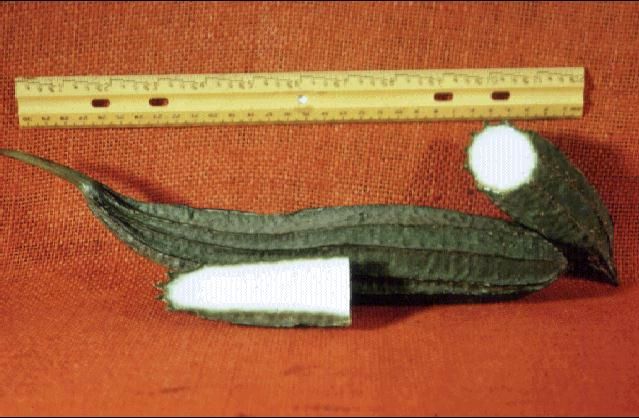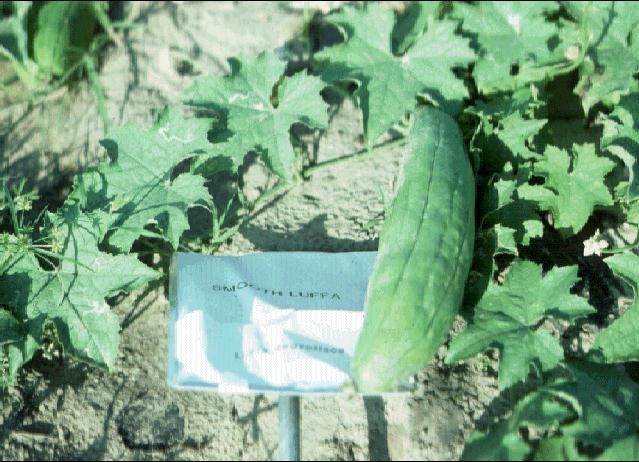Gourd, Luffa—Luffa cylindrica (L.) Roem., Luffa aegyptica Mill., and Luffa acutangula (L.) Roxb.1
Luffa is the genus name of a group of gourds also known as vegetable sponges, dishcloth gourds, running okra, strainer vine, Chinese okra, California okra, and loofah. Two species are commonly grown in this country and throughout Florida. Angled luffa is L. acutangula, while the smooth-fruited version is L. cylindrica, or the same as L. aegyptica.

Credit: Blue Goose, Inc.

Credit: James M. Stephens
Description
Both luffas have value as food items, but are seldom eaten in Florida. Most gardeners grow them for their fibrous interior, which is useful as a rough cloth or sponge for cleaning and scouring. The two species are somewhat similar in appearance. Both are vigorous, climbing, annual vines with several lobed cucumber-like leaves. When crushed, the leaves give off a rank odor.
Both male and female flowers occur on the plant with a much greater number of male flowers. The rather large male flowers are bright yellow and occur in clusters. The female flowers are solitary and have the tiny slender ovary attached. Angled luffa flowers appear later in the day than the smooth type and stay open through the night. Bees pollinate the flowers. Leaves are covered with short stiff hairs. Smooth luffa fruits are shaped like cucumbers but are larger, 1 to 2 feet in length and 4 to 5 inches thick. The exterior is green, sometimes mottled, and smooth with longitudinal lines. Fruits of the angled luffa are characterized by sharp, elevated ridges running the length of the pods. The interiors of both are cucumber-like when immature, but quickly develop a network of fibers surrounding a large number of flat blackish seeds. Smooth luffa seeds are a bit more narrow and have a pitted appearance.
Culture
Luffa is a warm-season, cold-sensitive genus originating in India. Both species grow throughout the tropics, including subtropical Florida. Luffa is grown mostly as a novelty in Florida gardens. However, some have been tried commercially for the sale of the sponges. Being cold sensitive, luffas should be grown during the warm season.
Luffa requires a lot of space, so plant seeds in hills spaced 6 feet apart or space plants about 3 to 4 feet apart in a single row. Provide a trellis or plant along a fence. Prepare the soil and fertilize just as you would for squash or cucumbers. Fruits touching the soil develop decay, so mulch will be helpful.
Use
Small (less than 6 inches long) young luffa gourds are used as a vegetable either prepared like squash or eaten raw like cucumbers. Some varieties are sweeter than others, particularly of the smooth type. Bitter types should not be eaten, as some poisonous properties have been reported.
However, best sponges come from mature-green fruits, although dry fruits may be used. The fruits should be soaked for several days and then peeled. Once cleaned, the sponges should be bleached and then dried in the sun. Sponges have been used for cleaning, filtering, and bathing.


